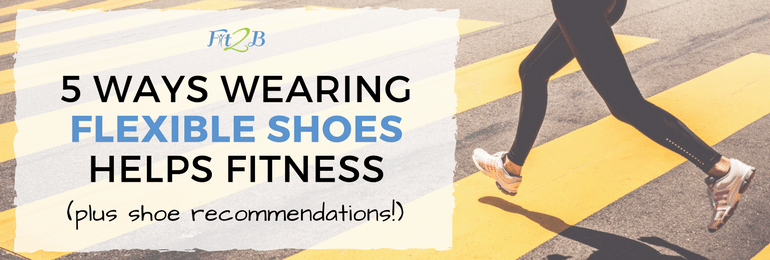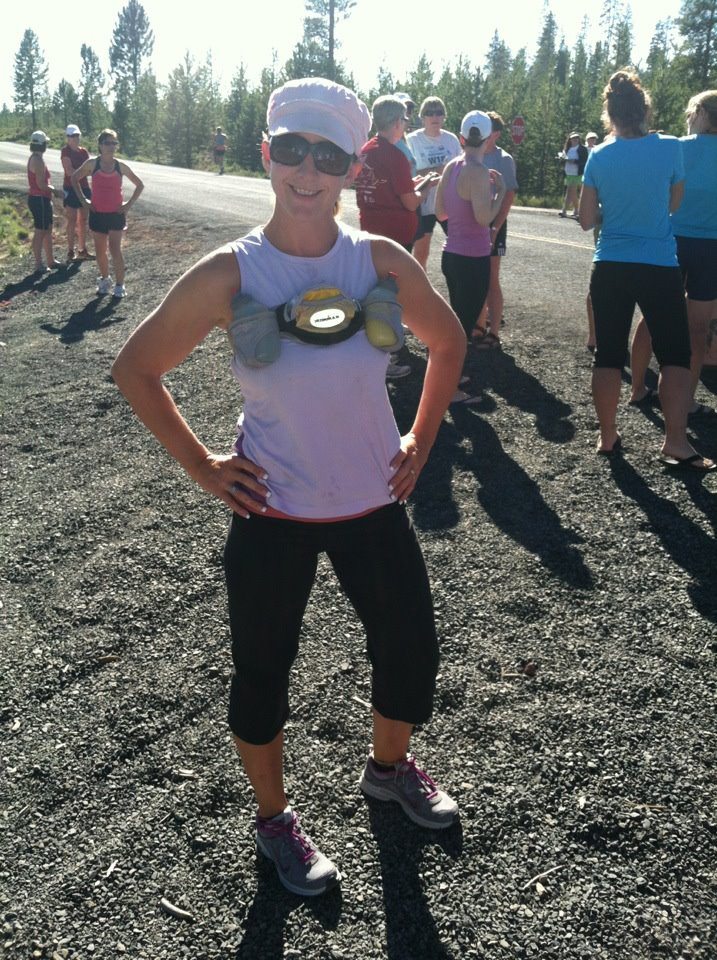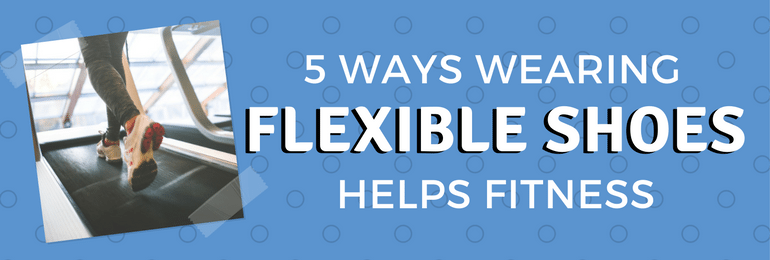Blog
5 Ways Wearing Flexible Shoes Helps Fitness
A picture that spoke a thousand words to me several years ago showed two feet balancing on two small rocks, wearing two different shoes. One was encased in a hiking boot with ankle support, while the other was in a minimal shoe. It was instantly very clear to me how flexible shoes help our fitness.
Minimal shoes are known for having less support, less heel-lift, maybe even less protection for the foot, but not always. At least that’s what I thought before seeing that picture of two feet on one trail. The idea of sacrificing my comfortable, padded sneakers with arch support and deep treads was asinine to me… Oh, how I wish I could remember where I saw the image so I could credit the author because they likely saved my feet and many other body parts!
I’m so not even being dramatic here. Bunions “run” in my family. Seriously, here are pictures of my mom’s surgery for it. Also, my feet are huge, and apparently so is my ego, so I spent way too much time as a prideful college girl crowding them into smaller sizes that looked cuter. No more. Done.
I’ve since learned both through more research and personally how letting our feet be our feet {and do the jobs our feet are designed to do} can positively impact many areas of our fitness.
Here are 5 ways wearing flexible shoes helps fitness:
#1 Your Proprioception Increases
Proprioceptors are the type of nerves within your body that tell you where you are without having to look. You can close your eyes, move your hand, and still sense where your hand is located. You can be walking and NOT have to watch your feet because you can feel where they are. Feet are meant to offer valuable feedback about where and what is underneath them. Thick-soled shoes diminish that feedback.
#2 You Protect Your Knees
Back to that picture I mentioned. Here’s what blew my mind, and it was so simple: the foot in the sturdy hiking boot was torqued to the side because it couldn’t mold around the rock. The stiffness of the sole made the foot knock sideways, instantly putting all that ankle support to use, yet it obviously still failed to protect the knee which was clearly also being torqued. Meanwhile, the foot in the minimal shoed foot was molding around and over the rock. The ankle was straight. The knee was straight.

#3 Your Calf Flexibility Improves
Think of how you stretch your calves. You have to bring your toes up toward your knees. You have to decrease the angle in the front of your ankle joint. When your calcaneus bone is constantly higher than your toes thanks to elevated heels, you are constantly doing the opposite of stretching your calves; you’re shortening them! And then you train athletically in a short-calf shoe, too? No thanks!
#4 Your Core Gains Functional Strength
When you step on a rock in stiff shoes, your core gets tasked with rebalancing you unnecessarily. Your core has a lot of jobs that shouldn’t include taking up the slack from shoes that outsource your footwork. When your shoes are flexible, your fitness within your core improves. Conversely, thick shoes on even terrain also take away work from your feet. They do all the balancing work for you!
#5 Less Soreness
Because my feet aren’t sore in calf-shortening shoes, they are more limber. They are accustomed to doing more work. So when I take them hiking, they don’t complain as much. When I take them on races, they respond faster to stretching. They don’t cramp on me. I realize this is purely anecdotal, but I’m not alone. So, there.
Notice I’ve used two words: Flexible and Minimal. They aren’t quite the same.
A minimal shoe will be flexible, but a flexible shoe might not be minimal. I transitioned into more minimal shoes over the course of 2 years — a method that Katy Bowman of Nutritious Movement recommends along with this list — by first seeking out more flexible shoes with a lower heel.

The next time I needed shoes, I found some that were even more flexible and lower in the heel. And so on, and so forth. Each time I needed new shoes of any sort — even barn boots and dress pumps — I’d opt for a slightly more minimal model, gradually minimizing how much was coming between my feet and the earth.
Come shoe shopping with me, and we’ll bend all of them together!

Two years ago, during the Cascade Lakes Relay, I used some Vibram 5-fingers for one of my legs and my Sketchers for my second leg to give my feet a break. Last year during the Portland To Coast relay race, I used these Merrell pace gloves for 2 legs and my Sketcher Go Walks for the 3rd leg. This year, I did the whole training season AND all three of my legs with another set of Merrells. That was almost 20 miles on PAVEMENT with zero heel but yet good protection.
As you transition to more flexible shoes to help your fitness and feet, you’ll find your favorites. You’ll find what works for your body and lifestyle. Recently, I opted for a tiny bit more support and tread — but I still kept them flexible — when purchasing a trail shoe that will let me climb the mountains that are on my bucket list for 2018… Three Sisters, anyone?
Yeah, because here on Fit2B, we aren’t just working out to my streaming home fitness videos for the sake of doing more workouts. We are getting stronger to get out there and live life and see this world!
Talk to me, friends!
Have you tried more minimal, flexible shoes and seen how they help your fitness? Also, what are your fitness goals? Leave me a comment below!



I want to get some but have always thought the five finger shoes were the only ones available for this concept. I am definitely going to get some different styled ones and start the transition now! Thank you for sharing this!
Fitness goals for 2018 are to stick with it! I have a tendency to either be sort of doing it or not doing it at all, “it” being healthy eating and exercise. I saw a photo of myself from this past weekend and knew it’s now or never. So I have ordered a new cookbook and invested in a tummy team splint. Let’s do this!
Oh yes, there are soooo many great minimal shoes now, and the transition is so worth it! Here’s to 2018 being the best ever!
i have recently been to the foot doc for a number of foot ailments including plantar factitious, pronation, collapsing arches, bunions and the most bothersome, tight/short Achilles Tendons…causing numb toes, ball of foot pain and such….he recommended supportive shoes and heel lifts or inserts. running shoe store recommended brooks adrenaline. these are far from minimal….is minimalism with shoes for everyone? id appreciate any feedback;) i have every intention of starting your program. you seem to have a very balanced view of fitness and i have pelvic floor prolapse issues, not DR. i have a subscription to another fitness company and its extreme and i have to modify everything and they don’t teach proper anything! as soon as that subscription is up, I’m all yours:) Im hoping to avoid surgery to correct my prolapse at least foor now and at the very leasy, strengthen myself for recovery if it comes to that. thank you for whay you do!
Give your feet what they need for now, but start eyeballing transition footwear AND use our “Fingers & Toes” routine to stretch and strengthen your feet. A more supportive shoe has its place, but if we don’t rehabilitate our feet and strengthen those muscles while essentially splinting them, then they will just get weaker and more dependent on those devices… er, shoes. 😀
You might find it easier to transition if you get some more minimalist shoes to wear for short bursts of time when you’re doing something less demanding — around the house, for instance — and then gradually increase the time in the more minimalist shoes and reduce the time in the ones with more artificial support.
I love my Earth Runners. I use them to do CrossFit. Definitely, the only in the gym using “sandals”. But they conform to my feet and I am never sore after running miles or doing sprint training.
I am always barefoot inside my house, and sometimes briefly outside, but when I walk outdoors, it’s almost always on pavement/concrete. I have not yet started transitioning, other than to eschew high heels forever. Do I already have a leg up by being barefoot most of my day, even though it’s usually indoors? (I’m a SAHM.) I grew up barefoot all summer as a kid, so I have wide feet, but not sure how strong they are anymore. Where would be a good place to start? Walking around the neighborhood is usually my only outdoor exercise. Not a runner or hiker. Thanks!
Pingback: All the Best Walking Resources | Fit2B Studio
what happens when you wear low flexibility shoes?
That depends on each person and what their foot needs are. Certain situations call for more support which many low-flexibility shoes are providing. However, extra cushioning and firmer arch support often mean less flexibility to shoe overall. The more support we give our feet, the more they need that support. Muscles in the foot are supposed to provide the arch of the foot and that “spring” of shock absorption. When arches are weak or collapsed, extra arch support feels good and keeps the feet happy… for a while. But we know from walking casts vs. regular casts that one helps the foot get stronger and heal faster. If we put our feet in “casts” all day and then go to bed, the myriad number of muscles in the feet will never get the work they need to get stronger. As I have shifted into wearing flexible shoes over the past years, I have experienced fewer and fewer foot problems. Whereas before, I kept seeking more and more support and experiencing more and more issues.
I really like this suggestion of flexible shoes. Everything about the concept makes total sense to me. Here’s the however: I broke my lower leg near the ankle in four places in December 2011. I now have have 9 screws and 2 titanium plates in that leg. I was and still a walker/hiker … walking as much as 7 miles per day. Sometimes more, depending on the destination. I like hiking on rough terrain with my son. My point here … I wear very expensive high to hiking boots as well as low top, depending (again) on where I am walking/hiking. It provides me with the ankle support I feel I need. Reading your post … perhaps not.
I am 71 years old. With that said, I do watch where I am going. I wish I was aware of wearing flexible shoes when I was younger. It might not have prevented the breaks I had, however, as it was caused by slipping in soft soil & mud.